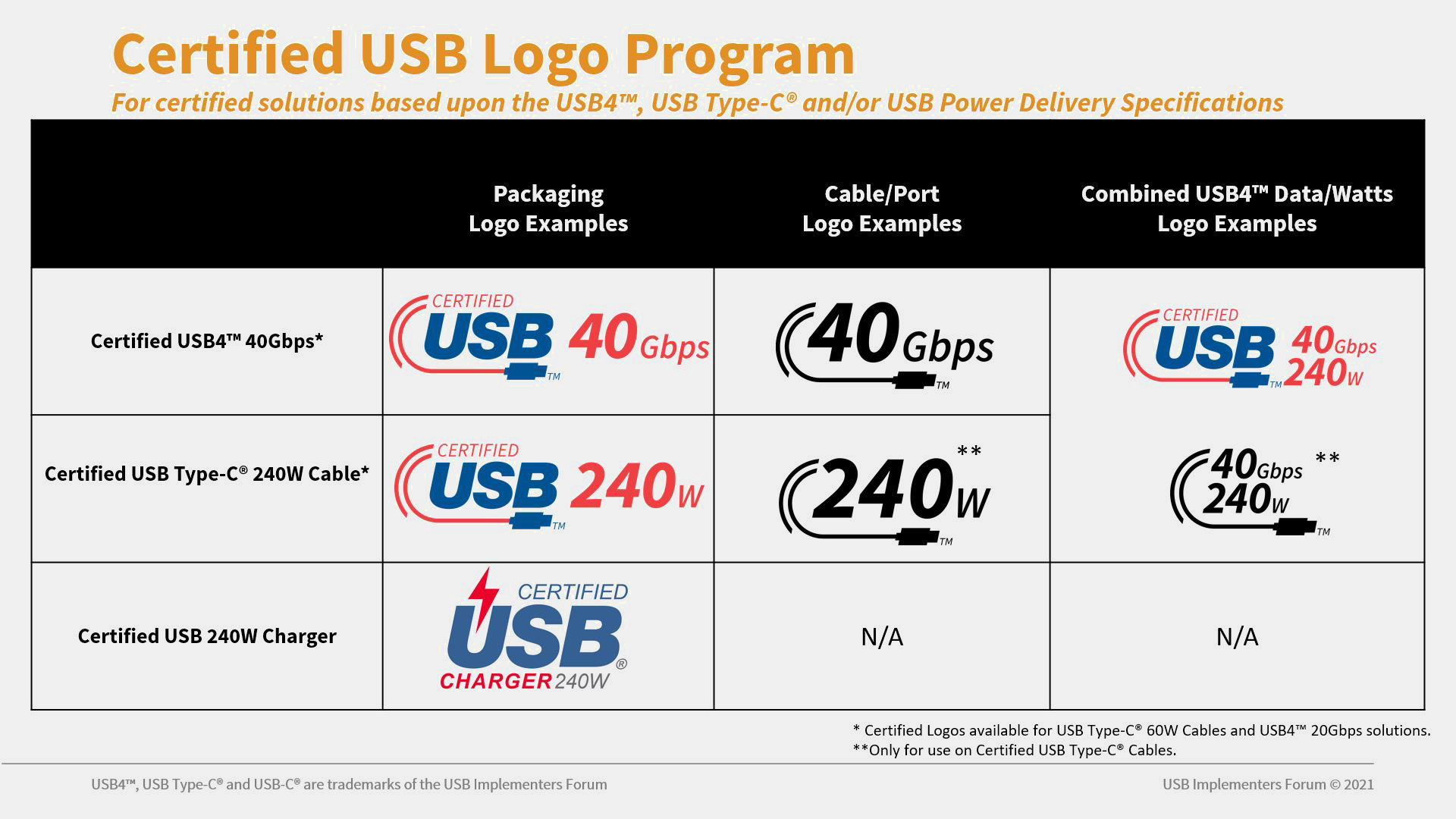New USB Logos Show Charging Capabilities Up to 240W
USB-C cables and chargers to get new logos.

Earlier this year, the USB-IF introduced USB Power Delivery specification 3.1 that brings support for 240W power delivery over the USB Type-C cable and connector. While increasing the power delivery capabilities of USB-C will be a boon for users (when devices actually come out), finding a USB cable that supports the required combination of features could be a confusing. To address this, USB-IF has unveiled logos that will be placed on the packages of certified USB chargers, cables, and devices in a bid to clearly indicate their capabilities.
From now on, certified USB Type-C cables will carry logos highlighting support for 60W or 240W of power delivery capability. Another logo will emphasize supported data transfer rates (e.g., 40Gbps in the case of some USB 4 products), whereas the third one will reveal both data transfer rate and power delivery capabilities. There is also a new logo for 240W-capable chargers.
"With the new higher power capabilities enabled by the USB PD 3.1 Specification, which unlocks up to 240W over a USB Type-C cable and connector, USB-IF saw an opportunity to further strengthen and simplify its Certified Logo Program for the end user," said Jeff Ravencraft, USB-IF President and COO. "With our updated logos, consumers can easily identify the USB4 performance and USB Power Delivery capabilities of Certified USB-C Cables, which support an ever-expanding ecosystem of consumer electronics from laptops and smartphones to displays and chargers."

Logos will be placed only on the packages of certified cables, hosts, and chargers. However, there are many products that will be capable of delivering these specs but where the manufacturers don't spend the time or money to have them certified. But, if you want to feel confident in knowing what a cable, charger or device can do, look for these marks.
Get Tom's Hardware's best news and in-depth reviews, straight to your inbox.

Anton Shilov is a contributing writer at Tom’s Hardware. Over the past couple of decades, he has covered everything from CPUs and GPUs to supercomputers and from modern process technologies and latest fab tools to high-tech industry trends.
-
ThatMouse And a billion usb ports installed around the world go obsolete as they up the voltage.Reply -
Krotow ReplyThatMouse said:And a billion usb ports installed around the world go obsolete as they up the voltage.
Nope. To enable higher voltage, you need USB charger who can enable higher voltages, device who can report a capability to charge in higher voltage modes and a cable capable to deliver enough power. And all high power capable USB cables have chip in one of connectors who return info to charger and devices as acknowledgement that you are using proper cable. Without that charger will stuck to 5V / 2A. -
Rdslw ALL USB's have backward compatibility to this point. new power levels though are a problem, at least at description level.Reply
I needed a charger that did 9V and 2.1 amps. that's 20W charger.
Most say 20W capable and that's it, it won't tell you that its 5V4A or 9V2A or 15V1.5A or 20V1A all of them or that any of them is missing.
Its even worse if charger have 2/3 slots, and 9V is only on one of them.
My phone charges with 5 or 9 Apple devices do only 5/12 or 5/20.
I am glad guys like anker show those on each product, but that should be standard info.
IMHO, they should force disclosure of all supported tiers on the packaging if they certify any level. any way that you could know this, if manufacturer suck, would be nice -
InvalidError Reply
Actually, the E-Mark chip is only required for current over 3A and USB-PD will happily deliver up to 20V/3A (60W) over plain dumb cables.Krotow said:Nope. To enable higher voltage, you need USB charger who can enable higher voltages, device who can report a capability to charge in higher voltage modes and a cable capable to deliver enough power. And all high power capable USB cables have chip in one of connectors who return info to charger and devices as acknowledgement that you are using proper cable. Without that charger will stuck to 5V / 2A.
For the new 48V "Extended Power Range" stuff, you need new cables with EPR chips in them since the old E-Mark cables have chips and possibly other components only designed for 20V. -
Alvar "Miles" Udell ReplyLogos will be placed only on the packages of certified cables, hosts, and chargers.
So how long until we see a recall where the wrong cables were placed in the wrong packages resulting in fires and damaged equipment...They should require a marking on the cable itself if it supports 240w, like one end being solid red. -
InvalidError Reply
I'm pretty sure "marking on the cable itself" is the whole point of the B&W "cable and port logos" in the logo table, just like the "SS" logos usually embossed into USB3.x cable connectors to identify cables with the extra high-speed lanes.Alvar Miles Udell said:They should require a marking on the cable itself if it supports 240w, like one end being solid red. -
Alvar "Miles" Udell ReplyInvalidError said:I'm pretty sure "marking on the cable itself" is the whole point of the B&W "cable and port logos" in the logo table, just like the "SS" logos usually embossed into USB3.x cable connectors to identify cables with the extra high-speed lanes.
I see the article has been corrected now. -
InvalidError Reply
Skip the conventional PSU altogether, go straight 48VO!DougMcC said:Only 240w? When am i going to be able to power my 1600w PSU off of usb?
Give each major component however as many type-C connectors as needed for however many adapters are required to meet their power requirements!